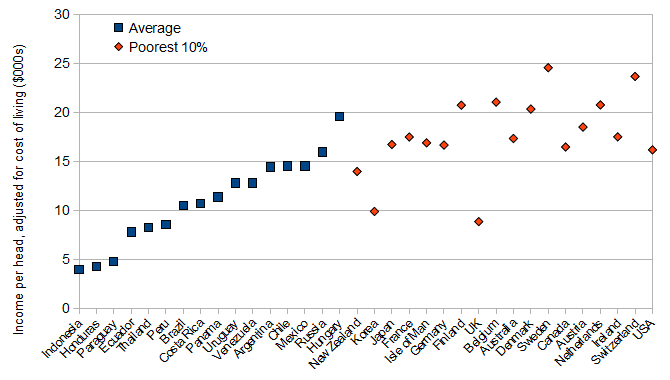In a recent post, Gerard O’Neill on his Turbulence Ahead blog gives his take on some of the recent research into the steady decline of absolute poverty. His upbeat take is a good complement to Bill Easterly, over on Aidwatchers.com, who applauds recent querying (by Angus Deaton among others) of the exactness and indeed necessity of statistics on poverty. (If nothing else, check out his revelation of the World Bank’s extraordinary statistical gymnastics on Indian and global poverty!)
All this talk of relative and absolute poverty made me think of the importance of hard and fast numbers like wages. After all, people are paid wages, not GDP. A couple of months ago, the ILO published the latest instalment of its Global Wage Report (with full access to its database). Naturally, a lot of the news coverage at the time was on the impact of the economic downturn on wages. In my opinion, the nature of the wage data collected by the ILO doesn’t really lend itself to up-to-the-minute analysis like that. The data are much better for reviewing what’s happened over longer timeframes.
One of the database’s most interesting contributions is on relative inequality. For a growing subset of countries, the ILO have figures on the average wages earned by the top 10% and bottom 10% of earners, as well as the median wage in the economy. For about 35 countries, there is information on wage inequality between top and bottom earners from the mid-1990s on. Sixteen of the countries are medium income or lower, i.e. have average per capita income of no greater than $20,000. While inequality fell in eight of those, that is hardly compelling evidence that there is a steady decline in inequality in the sample of 16, let alone all low and middle income countries. (Certainly not in Russia – where inequality has soared to level almost without global parallel in the last decade.)
In wealthier countries, on the other hand, wage inequality has typically risen since the mid-1990s – although it did fall in Belgium, Austria and (marginally) in France and Ireland. It’s important however, when people discuss inequality in wealth countries, that they bear in mind the overwhelming bigger picture: firstly, inequality is typically dramatically lower in rich countries than it is in poor, and secondly, even the poor in wealthy countries are better off than most people in the world. That’s not to say that inequality is not important, rather that most people had the choice of living in an equal society where average incomes are low or in a somewhat unequal society where even low income people are relatively well off, most people would choose the latter.
This is shown in the graph below. Using the top-bottom earner ratio, it’s possible to estimate the average income per person in the bottom 10% of wealthy countries, adjusting for the cost of living, and compare it to poor countries. The blue squares below are income per person, adjusted for cost of living, in the sixteen low/medium income countries covered in the ILO report, and the orange diamonds are average incomes of the poorest 10% of a range of high-income countries.
As you can see, the poorest in wealthy societies typically enjoy an average income of between $15,000 and $20,000 a year (those are US$ adjusted for cost of living in each country). In Korea – and also surprisingly in the UK – the bottom 10% live in conditions similar to the typical Latin American country, but elsewhere, the poorest live in conditions that average earners in even medium income countries like Chile and Russia would happily take.

Is this important? Well, yes, because the balance in importance between absolute and relative wealth is all too often misunderstood. It is now almost a truism to say that relative wealth matters more for happiness than absolute wealth. It is widely believed that people are happier when they don’t have to put up with significantly wealthier people than themselves. However, the most recent and most thorough research (you can read the research by economists Betsey Stevenson and Justin Wolfers at your leisure) into this so-called “Easterlin paradox” shows it doesn’t actually exist.
It may be a subtle distinction but making society less unequal is not what people want – they want to be better off. Making people better off is certainly not the only thing that makes people happy, but – holding everything else constant – making people better off does seem to make people happier, as measured by when you ask them whether they’re happy, surely an important metric. Not only that, this effect holds regardless of how wealthy they are to begin with. Society should not forget this.
AdamS ,
Thanks for the interesting post Ronan; the following is a link to an LSE public talk on happiness & economics, which seems to be very much an up & coming area:
http://www2.lse.ac.uk/publicEvents/events/2009/20090824t1436z001.aspx
Senan ,
“A rising tide, floats all boats” … and all that. Good article. My feeling is that people are much better off now, but everyone looks back nostalgically at ‘the good old days’. In reality of course, not so good.
Crelis ,
Have you seen this: Changing poverty criteria ‘drops’ the number of poor in India (Time, The Guardian, The Hindu, Russia Today); I’ve collected some information here: http://crelis.nl/?p=1911
Crelis ,
Regarding data on inequality in rich coutries: The gap between rich and poor in OECD countries has reached its highest level for over 30 years, according to an OECD report (see video post: http://crelis.nl/?p=1306).